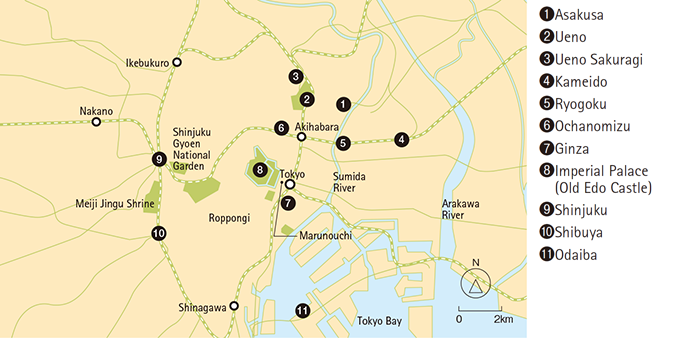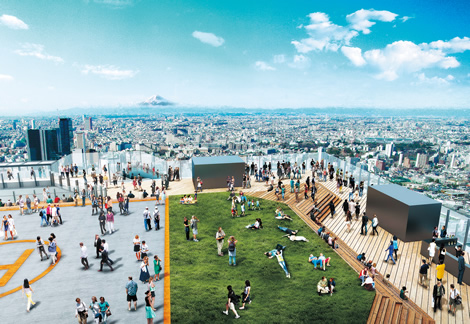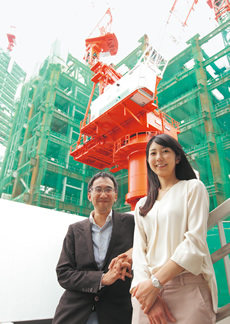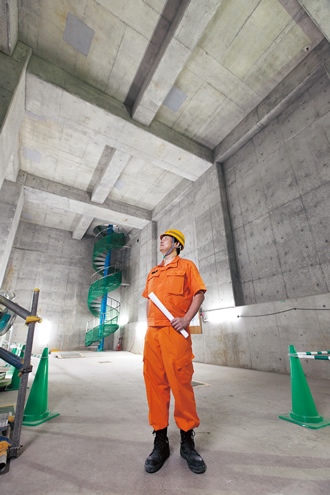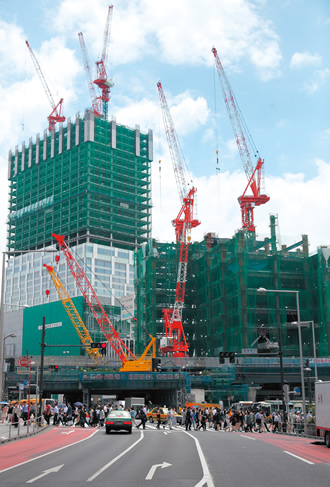niponica is a web magazine that introduces modern Japan to people all over the world.
2017 No.22
Tokyo, a 400-Year Narrative

Reinventing Urban Space for the Next Century
Shibuya Station is one of Tokyo’s major rail terminals, as shown by the photographs on the table of contents page. The area around the station is now undergoing what is said to be a once-in-a-century redevelopment.
The urban renewal projects aim to put people first and take Shibuya into the future.
Cooperation: Tokyu Corporation
Photos: Natori Kazuhisa
渋谷 Shibuya 2027
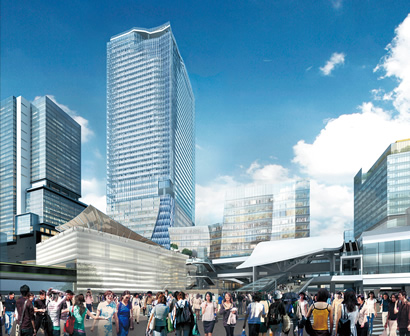
渋谷 Shibuya 2017
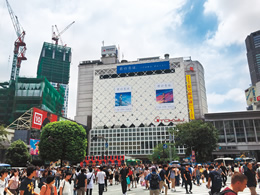
Left: The area in front of Shibuya Station today. Right: Image envisioning plans for the same area in 2027. New towering buildings will rise, and the diagonal crosswalk in front of the station’s west exit will be upgraded to provide a safer, more pedestrian-friendly environment. One of the new buildings will be topped off with an observation deck and leisure facilities. (Illustration courtesy of Shibuya Station Urban Collaborative Building Enterprise)
Shibuya has always generated new fashions and trends, and it is now one of the most sought-after office locations in the metropolis and home to many IT companies. To the many faces of the district, new ones are now being added—seven development projects, including four skyscrapers planned for completion by 2020. People eager to set up new businesses and promote new trends are attracted to Shibuya, bringing even more energy to Japan’s creative industries.
One of the major changes will affect pedestrian traffic in the station area. Today, trains on nine different railway and subway lines use the station, with platforms scattered from the fifth underground floor to the third floor above ground. The station interior is basically a maze. The platforms of these various lines will be brought closer together—no more than a few hundred meters apart—to make it easy for passengers to transfer from one line to another. Pedestrian circulation between floors deep underground and buildings above ground will be dramatically improved, offering space that is safe and hassle-free even for the elderly and people with small children.
Many other districts in Tokyo offer their own attractions, but the purpose of these redevelopment projects is to make Shibuya the place in Japan that people want to visit most.
Tokyu Corporation has taken the lead in Shibuya’s development since the mid-20th century. Yamaguchi Kantaro of the company’s Urban Development Business Unit explains, “Places like Harajuku, Aoyama, Daikanyama and Ebisu, which are all popular among the young and trendy, are within one or two train stops. It will also be fun to walk to those places on promenades built along the Shibuya River. In addition, public spaces are being constructed partway between those places and Shibuya for people to rest and relax. We’re promoting plans for large open areas where people can appreciate both Shibuya and its surroundings.”
The idea is to make Shibuya a destination where people want to be, a place for enjoying water, greenery and strolling about—in other words, to make it more than just a district of towering architecture. The idea is to shift the focus from buildings to people. Visitors of different ages, nationalities and occupations, with different interests, will be keen to come to Shibuya—a place where different ideas will be welcome, and new lifestyles, businesses and industries will evolve.
As it moves forward into the next hundred years, Shibuya will become a magnet for new energy. Shibuya’s future is already in sight.
Building near the station to feature a rooftop deck with space for viewing the Tokyo skyline. Utilizing the entire rooftop, this project will be one of the largest rooftop decks in Japan when completed. (Illustration courtesy of Shibuya Station Urban Collaborative Building Enterprise)
Shibuya’s unique flood prevention plan
To bring back waterscapes and greenery, Shibuya is promoting development along the Shibuya River. The district lies at the bottom of a shallow valley, so there is an urgent need for water control measures. The last few years have seen the occurrence of what is called “guerrilla heavy rain,” with more than 5 centimeters of rain falling in a single hour. Each time this has occurred, the station area at the bottom of the valley has been badly affected.
As a countermeasure, a subterranean emergency water storage tank is being constructed under the east exit of the station; it will prevent flooding during a heavy downpour. At Tokyu’s Urban Development Business Unit, Mori Masahiro is supervising construction of the storage tank, and he describes the project in a nutshell: “Our first step is to redirect the flow of the Shibuya River, which currently flows under an area in front of the station, and construct an underground concourse. Then, under this, at the deepest point some 25 meters below ground, we are constructing a storage tank that will be able to hold about 4,000m3 of rainwater. There, surrounded by subway lines, the river and buildings, the tank will store rainwater during a heavy downpour, preventing flood damage.”
More than three million people use Shibuya Station every day, and the construction is moving ahead without interfering with regular station operations. In some places, the work can proceed for only two hours at a stretch between the last night train and the first morning train. So precision planning is required. Construction continues apace, not constrained as one might expect in a busy place that is one of the largest rail terminals in the world.
The intermediate goal of the redevelopment project timeframe is the 2020 Tokyo Olympic and Paralympic Games, with everything scheduled for final completion in 2027. By that time, Shibuya will no doubt have become an urban center attracting admiration from around the world.
Map of Tokyo (2017)
This map shows the places that appeared in the Special Feature.
